What Does it Take to Make Your Own "Terminator"?
This is the BIG question everyone wants to know. How can I take the tried and proven combination that Ford came up with, and make my own "Terminator" Engine. Well I’m going to show you how.
The "Terminator" Engine is much, much more then just a 4.6L DOHC Modular Engine with a Blower on it. Tring to create such an Engine with used, worn and frankly inadequate parts is not a recipe for a high horsepower engine, it’s a recipe for Disaster. The DOHC S/C 4.6L Engine and all it’s internal parts are very different then those found in any other 4.6L Engine, even those in the Mach 1 Engine. What is so different ? I’ll list the parts in the Short Block and the Differences.
Crankshaft
The 4.6L S/C Engine uses a Forged Steel Crankshaft, with an 8-Bolt pattern Crankshaft Hub. All other Engines use a cast steel Crankshaft with only a 6-Bolt pattern on the hub. The 03-04 Ford Cobra Crankshaft is much stronger and more durable then the cast unit the other Engines use. The Crankshaft is the Hart of the Engine, sort of like the foundation of a home. No matter how nice a home you build on it, it is only good for so much load, exceed it’s capacity and you will lose your home. Same goes for the Crankshaft, if you want a true 03-04 Cobra Engine, then you have to start with a Forged Crankshaft, anything else is just a ticking time bomb. Stock "Terminators" or Ford 03-04 Cobra’s, were known as very Powerful but yet very Reliable Engines, they were engineered to run over 100,000 miles before requiring a re-build. I have seen the insides of many of these Engines, and can vouch for it’s durability. Without this vital piece, you have no Cobra Engine.
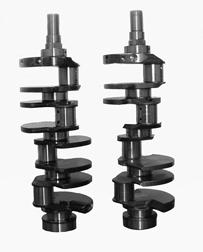
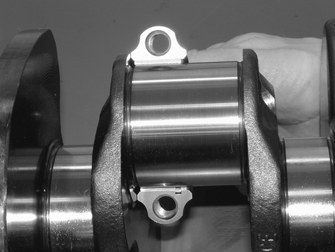

Rods
The Ford 4.6L S/C Engine used a very different Connecting Rod then any other modular Engine in the Ford stable. While all other Connecting Rods are made from powdered metal, those used in the 03-04 4.6L S/C Engine were Forged Steel. The powdered Rods start as a metal like mixture, ground very fine to form a powdery substance. The powdered metal is injected into a mold, or die where it distantly resembles it’s end product. Finally, the end part is formed by applying pressure, high temperature, long setting times (during which self-welding occurs), or any combination thereof. The Rods are formed with the end caps in-place, to separate the two from each other a line is scribed, much like when you cut glass or tile, and the cap is broken off from the Rod. Because there is no further machining involved, it is very important to not mix-up the Rod Caps when working on the bottom end, they are unique to themselves. The Forged Steel Rods the 4.6L S/C Engine used is from Manley, a long time manufacture of both Factory and Racing Engine parts. These Rods start out a one chunk of Billet Steel and are Forged under thousands of pounds of heat and pressure to form into the piece they use. They are then machined to tolerance and bushings installed. The caps are also Forged Steel, but are made separate not as a unit like the powdered metal ones. The Manley Rods use ARP, another High End Supplier, for the Rod Bolts that hold the two ends together. The finished product is carefully weighed and grouped in sets of eight, with a separation of ½ gram or less. These Rods are much more stronger then the powdered metal rods, they are also way more durable. These Rods have the advantage of higher RPM’s and loads then the other Rods used by Ford . Where these Rods will bend or deform under extreme stress, the PM Rods will simply snap in two, causing Catastrophic Engine Damage. It is not at all un-usual for these Rods to last 75-100 thousand miles and only require new bushings at time of re-build. The only option for those wanting slightly more "comfort room" when re-building or building your own "Terminator" Engine would be to use the Aurora 2000 Rod Bolts, which make the Rod assembly stronger, a great option to consider.
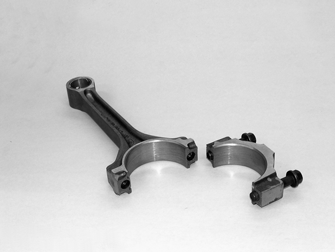
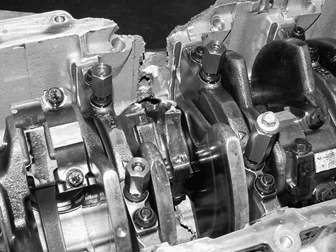
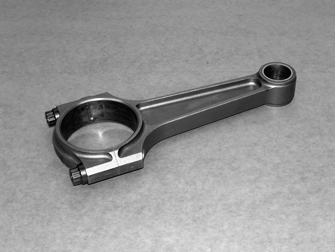
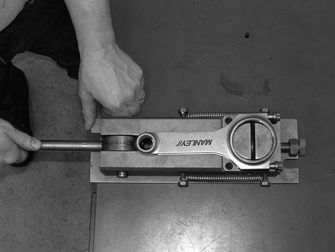
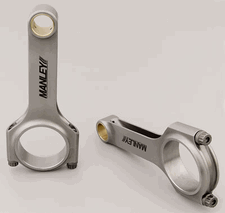
Pistons
Like the Rods the Pistons used in the Ford 03-04 Cobra Engine are Forged Pieces made by Manley. These Forged units are much stronger then the Cast or Hypereutectic Pistons used in the other Ford 4.6 and 5.4L Engines. Forged Pistons can endure much more abuse then the other two, abuse in terms of RPM, Cylinder Pressure, Heat, Stroke and Wear. Forged Pistons due a better job of staying round in the Cylinder Bore, and that keeps the Ring Faces in contact with the cylinders for more power. They do require more Static clearance then Cast or Hypereutectic Pistons, which means they may make some added noise at start-up, this goes away once the running temperatures are reached. Forged Pistons like the Rods, are much more Expensive then the alternative, one very good reason Factories don’t use them, COST.
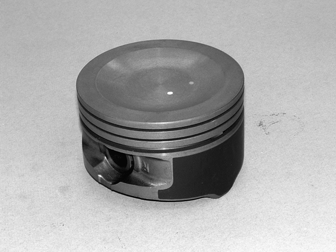
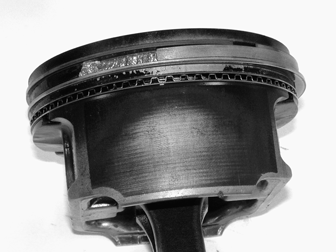
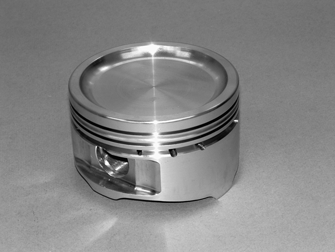
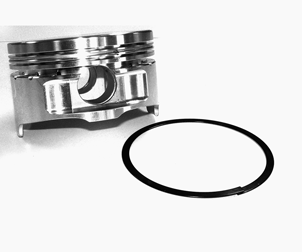
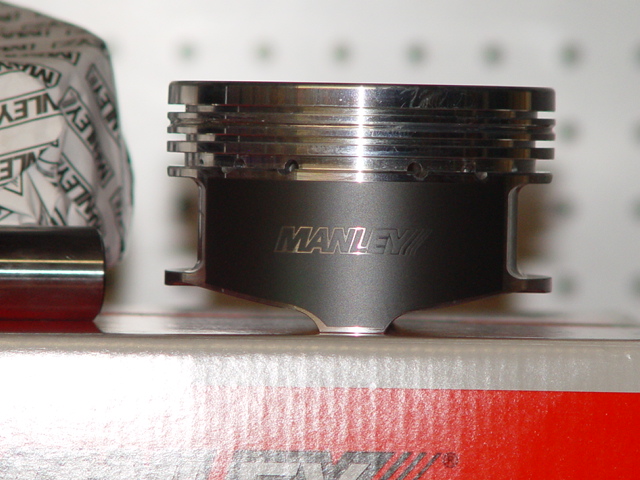
Oil Pump
The Oil Pump on the "Terminator" is larger in capacity then the other stock 4.6L engine. Because of higher demands placed on the Supercharged Engine, this Engine was given a slightly wider Oil Pump Housing, which allowed Wider Gears and high capacity. One area of concern on the S/C Oil Pump was the Gears themselves. These are made from Powdered Metal, and under certain conditions, mainly high RPM and Racing condition, can crack resulting in loss of oil pressure and engine failure. Most users would not be in danger of this happening to them, but if you think you may be pushing the Engine to it’s upper limits, then replacement gears, which are Forged Steel, would be a great ideal. The Oil Pick-up Tube form the Cobra Engine is also larger then the other 4.6 engines. It stands to reason that if you have a Oil Pump capable of more capacity, then you would need a larger Pick-up Tube to supply it.
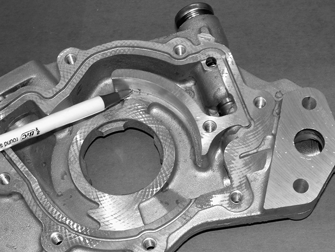
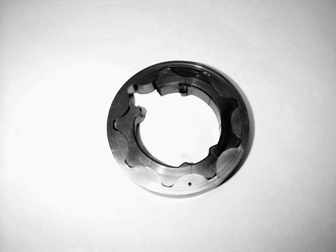
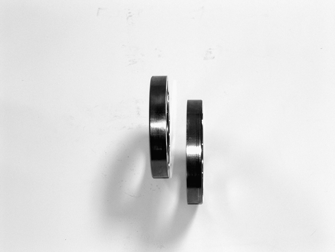
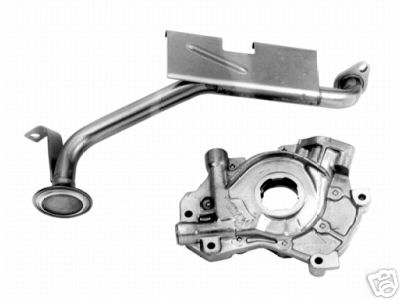
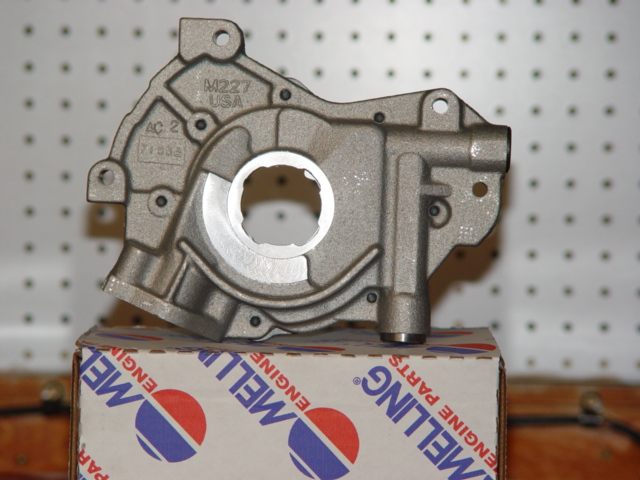
Engine Block
The Ford 03-04 Engine used a Cast Iron Engine Block, something very unique to that version of the Cobra Engine. Most Cobra Engines used an Aluminum Engine Block, which cuts down on front end weight by almost 85lbs.. Why did the 03-04 Cobra use the heavy Cast Iron Block ? That’s a long story, but I’ll try to condense it for you. In the beginning, 1993-94 when Ford first started using the 4.6l DOHC Engine, they used only Aluminum Blocks for the DOHC Engines and Cast Iron Blocks for the rest. The DOHC or 4-Cam Engines were premium Engines and only used in there premium vehicles, the Engine gave maximum power and the Aluminum Block saved weight and made huge strides in vehicle dynamics. The Aluminum Blocks were farmed-out to a place in Turin, Italy called Teksid. Naturally these blocks became know as Teksid Blocks, while Ford cast there own SOHC Engine Block themselves. Teksid is a world class leader in lost foam casting, and really made a great Block for Ford, in-fact these Blocks were so well built, they are still considered the Block to have for all High Performance Engines. Ford used Teksid, Blocks, number F6LZ-6010-AB, from 1994 to 1999 and 1999-2001 Blocks XR3Z-6010-CA. Then they started to cast there own Aluminum Blocks. Only problem was Ford changed the design and didn’t use the same quality materials or process to make their Engine Blocks. Conciquently, at the time the 03-04 Engines were being tested for reliability and performance standards, the Aluminum Block wasn’t capable of containing it. Ford reluctantly went back to the only Block they had in inventory that would work, the Cast Iron Block. Many people offen wonder what was Ford thingking, putting a heavy Cast Iron Block in the leading Performance Sports Car, knowing heavy nose weight kills perofrmance and agility. Now you know the rest of the story. If things would have worked out, the "Terminators" would have and should have come form the factory with lighter Aluminum Engine Blocks, not the Heavier Cast Iron ones. I look at it as a blessing, If Ford would not have caught this problem, or simply over-looked it, the 03-04 Engine might not have grown to enjoy the large following it has. If nothing else, The Ford 4.6L DOHC S/C Engine has always been durable and Reliable. Many 4.6L Engines come with just 2-Bolt Main Caps, the "Terminator" Engine has 4-Bolt Main Caps. As you would likely assume, with 4-bolts holding the Crankshaft in place, the DOHC Engine is much stronger then one with only 2-Main Cap Bolts.

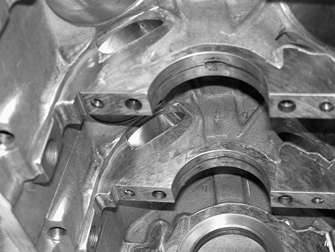

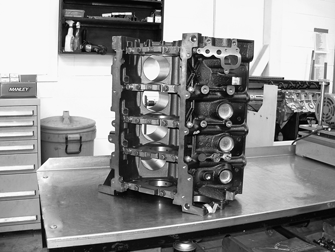
Windage Tray
The Windage Tray on the 03-04 Engine is also unique to that particular engine. It is both longer and wider then the others, and offers greater protection from windage losses.

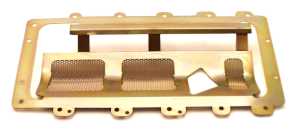
Timing Cover
The Front or Timing Cover on the 03-04 Engine is a unique piece, it is the only Front Cover that will work with the supercharged engine. Physically they are dimensionally all the same, it’s the lay-out of the front cover that makes them unique. The Supercharged Engine has Two Accessory Drive Systems, one for the Supercharger and the other for Accessories. The Supercharger Drive, because of the added resistance it has, uses a 8mm wide Drive Belt, which also means the Pullies have to be 8mm wide. The Accessory Drive uses only a 6mm wide Drive Belt and Pulley. The Front Cover to the "Terminator" is one of the most sought after pieces on E-bay. They are realativly rare, and go quick when one is listed, expect to pay a premium for one it you find one. The only alternative for this cover is to buy a new one from Ford, and there they list for almost $700.00. If you ever run across one of these Front Covers, purchase it, even if you don’t intend to build a "Terminator" Engine, they are money in the bank.

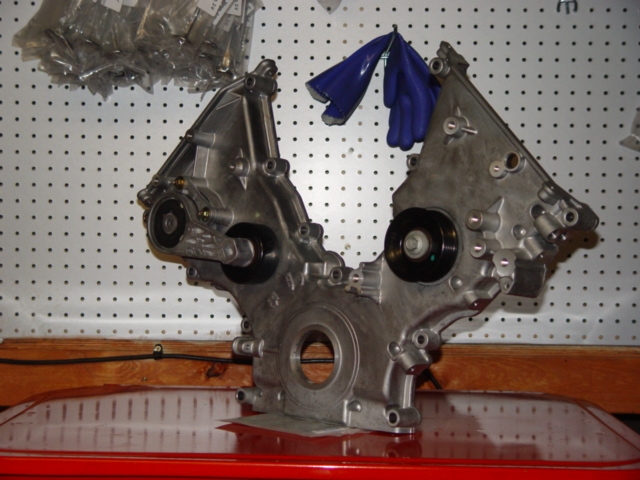
Oil Pan
The Oil Pan used on the 03-04 Cobra engine is a good piece, but if you are building one from scratch, I would think the Moroso 7qt. Oil Pan would be a much better choice. It has Extra Oil Capacity, comes with 2-seperate 1/2" NPT fittings for Oil Temp Sensors or special return fitting, all ready installed. It will cost more, a Stock Oil Pan is about $50.00 where the Moroso Oil Pan would run closer to $250.00. The stock Engine Oil Level Indicator will fit both pans, but I like to switch it out for the Lokar Billet/Flexible Oil Dip Stick. It looks great and is more flexible with regurads to location, they run about $45.00.
These were the differences on the Short block, and as you have seen, are very much different then any stock factory engine of the modular family. These differences can not be overlooked or under estimated when building your own personal "Terminator" Engine. Next we will look at the rest of the Engine, and see what makes the 4.6L DOHC S/C Engine so different.

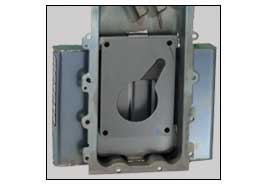
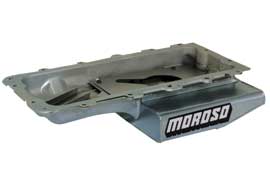
Ignition
The Cobra Engine uses Coil-on- Plug Technology, this is also shared with the other Engines in this family, but the 4-Valve engine has a unique Ignition Coil, one that will only work with the 4-valve Cylinder Heads and Valve Covers.

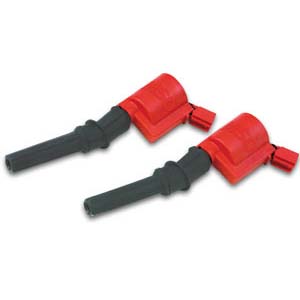
Valve Covers
4-Valve, Valve Covers are much larger and wider then 2-Valve Valve Covers. But the 03-04 engine share the same Valve Cover with the rest of the 4-V Engines. While the aftermarket has been slow to address the Engines Valve Covers needs, there are two versions from Ford Racing that really dress's-up the engine, they are the Powder-Coated Blue and Chrome like Valve Covers.
The 4-valve Engine also use a Coil Cover, this piece covers and protects the coil-on-plugs and there wiring. As with the Valve Covers, Ford Racing offers several alternatives to the stock factory pieces.


Cylinder Heads
The Cylinder Heads on the 03-04 Cobra Engine are differnet from the other DOHC Engines. They use there own casting, and differ from thew 99-04 DOHC Heads. These Heads are know in the industry as "C" Heads or "Tummble Port Heads". These Heads use 37mm Intake Valves and 30mm Exhaust Valves. They have a Rocker Arm Ratio of 1.79:1 and a Compression Distance of 1.220, and a Stock Compression Ratio of 8.50:1. These Heads were the first DOHC Heads to have a dedicated Left and Right casting, which cured the Hot spot normmally found on the Left side cylinders 6,7,and 8.
Camshaft
The 03-04 Cobra Engine had it's own special Camshaft. This piece was built specificly for the Eaton Blower and proved to be a very good and universal piece. When you switch over to the 03-04 Cobra Engine, you have to also install this Camshaft, or you will not get the full benifit from the Blower and you will not have a 03-04 Cobra Engine.
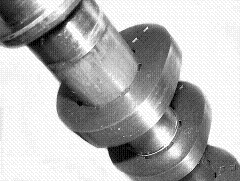
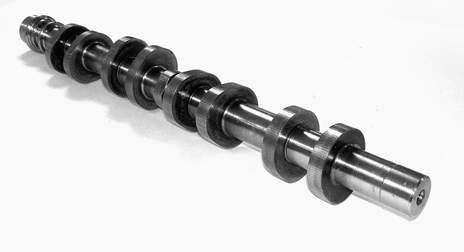
Exhaust Manifold
4-Valve Engines have a different port design then 2-Valve Engines, while the 4-Valve ports are the same as other 4-vale engines, the factory cast iron exhaust manifolds are unique to the 03-04 Cobra. Aftermarket suppliers have several different headers available for the 03-04 Cobra Engine. These have proven to be wise and very popular additions among Cobra owners and can increase torque and horsepower.

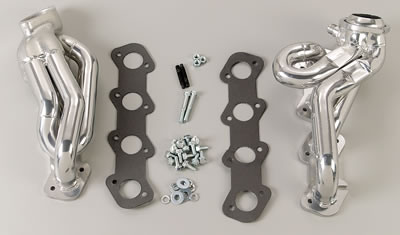

Engine Oil Cooler
The 03-04 Engine has a engine oil cooler unique to it’s self. This oil cooler is located on the drivers side, front of the Engine block and uses the Engine coolant to help cool the Engine oil. The Engine oil filter mounts directly to it. There is a large 1-1/2" hose that comes from the thermostat housing to feed the cooler.

Power Steering Pump
The Power steering Pump is also mounted to the drivers side of the Engine block, right above the Oil Cooler/Filter assembly. This pump and it’s pulley is unique to the "Terminator" Engine.
Alternator
Like the Oil cooler and power steering pump, the alternator is also mounted on the drivers side, just above the Power Steering Pump. This is different then all other modular Engine, most have the alternator located in the center on the Engine just above the timing cover and in front of the intake manifold. Because of the supercharger, the alternator was moved to the side of the Engine. There is also and upper and lower bracket that keeps the alternator in place. The Alternator Pulley is 8mm wide and is driven by the supercharger belt.

Thermostat
Most 4-valve Engines have a remote mounted Thermostat and Housing. This is very unusual for most Engines, most have the Housing and Thermostat located on the front portion of the intake manifold. The Housing itself comes in two separate pieces, connected by 2-small screws and 1-O-ring. The Thermostat itself, sits on the inside, and the housing has large three hoses connected to it. One from the bottom of the radiator, one to the cross-over water tube, and the other to the engine oil cooler. It’s not so un- likely that these engines have a hard time ridding themselves of air, once the system has been opened. A trick many prefer to use, is to drill two very small (1/8") holes in each side of the thermostat, 180̊ part, this allows the trapped air to escape, making it much easier to bleed after repair. When transplanting the engine into other vehicles remember that there are many obvious and some not so obvious differences between the Ford Engine and others. These Engines use a separate piece to fill the cooling system, while most other engine use a cap on the radiator.


Front Drive
The Front Drive Assembly on The Ford 03-04 Cobra has a very special and unique set-up. Because of the Supercharger, there was a need for a Double Drive System, and only the "Terminator" Engine has it. This system has an Inter and Outer Drive System, so we will break them down accordingly.
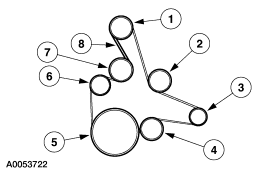
| Item |
Part # |
Description |
|---|---|---|
| 1 | Supercharger Pulley | |
| 2 | 8678 | Beld Idler Pulley |
| 3 | 10344 | Generator Pulley |
| 4 |
8678 | Belt Idler Pulley |
| 5 | 6C254 | Crankshaft Extension Pulley |
| 6 | 6B209 | Belt Tensioner |
| 7 |
8678 | Belt idler Pulley |
| 8 | 8620 | Drive Belt |
Component Location - Accessory Drive

| Item |
Part # |
Description |
|---|---|---|
| 1 | 8678 | Belt idler Pulley |
| 2 | 8678 | Beld Idler Pulley |
| 3 | 8678 | Belt idler Pulley |
| 4 |
3A733 | Power Steering Pulley |
| 5 | 10344 | Coolant Pump Pulley |
| 6 | 6C254 | Crankshaft Pulley |
| 7 |
6B209 | Belt Tensioner |
| 8 | 19D784 | AC Compressor Pulley |
| 9 | 8620 | Drive Belt |
General Specification
| Item |
Specification |
|---|---|
| Accessory Drive Belt | 6 ribs |
| Supercharger Drive | 8 ribs |
Torque Specifications
| Description | NM | lb-ft | lb-in |
|---|---|---|---|
| Belt Idler Pulley Bolt | 25 | 18 | - |
| Drive Belt Tensioner Bolt - 4.6L | 10 | - | 89 |
| Drive Belt Tensioner Bolt Supercharged Engine | 25 | 18 | - |
| Cooling Hose Mounting Bolt | 25 | 18 | - |
| Belt Idler Support Assembly Bracket Bolts | 25 | 18 | - |
| Air Intake Scoop Bolts | 25 | 18 | - |
| Air Intake Scoop Bracket Bolt | 25 | 18 | - |
| Air Intake Scoop Bracket Nuts | 9 | - | 80 |
| Air Intake Scoop Bracket Throttle Body Nut | 9 | - | 80 |
| Exhaust Gas Recirculation (EGR) Vacuum Regulartor Solenoid Bolts | 10 | - | 89 |
Back To Top
